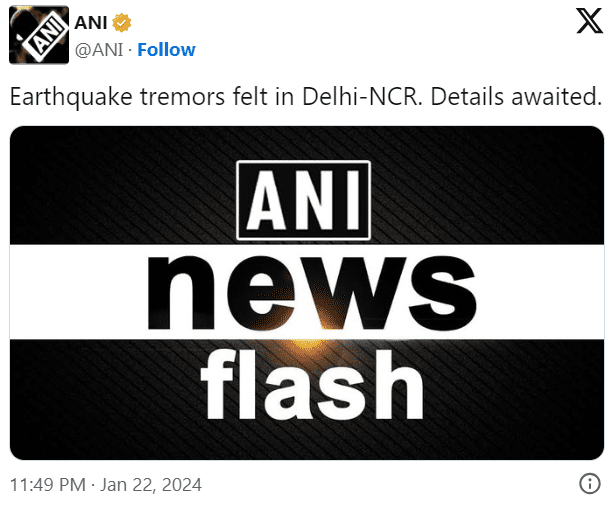Intense Earthquakes Shake Delhi-NCR Following Tremor in Northern India on Monday Night.
2 min read 2024-01-23, 04:20 PM IST
Highlight of the Story
- Strong earthquakes were felt in the Delhi-National Capital Region (NCR) after a significant seismic event in northern India on Monday night.
- The seismic activity in northern India was a result of a powerful earthquake with a magnitude of 7.2 in the Southern Xinjiang region at 11:29 PM IST.
- The National Centre for Seismology reported the earthquake on social media platform X (formerly known as Twitter).
- Earlier on Saturday, the Andaman and Nicobar Islands experienced an earthquake with a magnitude of 4.4 on the Richter scale around 7 AM on January 20.
- The National Centre for Seismology provided detailed information about the Andaman and Nicobar earthquake, including its magnitude, location, and depth.
- The seismic events in Delhi-NCR and the Andaman and Nicobar Islands highlight the diverse earthquake-prone areas in India.
- The interconnectedness of seismic events across regions raises questions about earthquake preparedness and the need for a coordinated approach.
- Delhi-NCR’s urbanized and densely populated nature underscores the importance of stringent building codes, early warning systems, and public awareness to mitigate seismic impact.
- The earthquake in China prompts attention to the potential for widespread impact and the urgency for regional cooperation in managing seismic risks.
- The role of technology and social media platforms, such as X, in disseminating real-time information during seismic events is emphasized.
- The scientific aspects of seismic activity are discussed, including the Earth’s tectonic plates, the Indian subcontinent’s susceptibility to earthquakes, and the measurement of earthquake magnitudes.
- The occurrence of earthquakes in quick succession raises concerns about the seismic stability of affected regions.
- Human activities, including mining and reservoir-induced seismicity, can contribute to increased seismic risks.
- The story concludes by emphasizing the need for robust earthquake preparedness measures, effective early warning systems, and community engagement to build resilience against future earthquakes.

In a recent seismic event, strong earthquakes were felt in the Delhi-National Capital Region (NCR) after a quake struck northern India on Monday night. The tremors were reportedly a consequence of a significant seismic activity in the Southern Xinjiang region, where an earthquake with a magnitude of 7.2 struck at 11:29 PM IST, as reported by the National Centre for Seismology. This unsettling event has drawn attention to the seismic vulnerability of the region, prompting concerns about preparedness and response measures.
ALSO READ| Earthquake shocks Delhi-NCR.
The seismic activity was not isolated to the mainland, as earlier on Saturday, an earthquake with a magnitude of 4.4 on the Richter scale jolted the Andaman and Nicobar Islands. The quake occurred around 7 AM on January 20, adding to the series of recent seismic events that have been recorded in various parts of the country.
The National Centre for Seismology provided detailed information on the Andaman and Nicobar earthquake: “Earthquake of Magnitude: 4.4, Occurred on 20-01-2024, 07:06:19 IST, Lat: 9.97 & Long: 93.54, Depth: 11 Km, Location: Andaman and Nicobar island.” This seismic activity serves as a reminder of the geographical diversity of earthquake-prone areas in India and the importance of monitoring and responding to such events.
ALOS RAED| Earthquake Strikes Japan; A Nation Grapples with Devastation and Resilience.
As the tremors in Delhi-NCR were felt following the earthquake in China, it raises questions about the interconnectedness of seismic events across regions and the need for a coordinated approach to earthquake preparedness. Delhi-NCR, being a densely populated and urbanized area, underscores the importance of stringent building codes, early warning systems, and public awareness to mitigate the impact of such seismic occurrences.
The Southern Xinjiang earthquake, with its substantial magnitude, emphasizes the potential for widespread impact and the urgency for regional cooperation in managing seismic risks. It also brings attention to the role of technology and social media platforms, like X (formerly known as Twitter), in disseminating real-time information and updates during such crises.
ALSO RAED| 6.1 Magnitude Earthquake in Afghanistan Felt in Delhi-NCR Today.
In the aftermath of these seismic events, it becomes crucial to assess the preparedness and resilience of affected regions. Understanding the geological and seismological aspects of these earthquakes is essential for implementing effective measures to mitigate damage and ensure the safety of the population.
- Delving into the scientific aspects, seismic activity is a result of the Earth’s tectonic plates interacting with each other. The Indian subcontinent is particularly susceptible to earthquakes due to its position on the converging boundary of the Indian and Eurasian plates. The release of energy during these interactions can lead to earthquakes, and the scale of these events is measured using the Richter scale or other magnitude scales.
- It is noteworthy that earthquakes are not isolated incidents, and their occurrence in quick succession raises concerns about the seismic stability of the affected regions. The Southern Xinjiang earthquake, occurring in a seismically active zone, prompts a closer examination of the region’s seismic history and the potential for future seismic events.
- While earthquakes are natural phenomena, human activities such as mining, reservoir-induced seismicity, and other anthropogenic factors can contribute to increased seismic risks. Understanding the interplay of these factors is essential for developing comprehensive strategies to minimize the impact of earthquakes on both human life and infrastructure.
In conclusion, the recent earthquakes in Delhi-NCR and the Andaman and Nicobar Islands serve as stark reminders of the seismic risks faced by diverse regions in India. The interconnectedness of seismic events and the potential for widespread impact necessitate robust preparedness measures, effective early warning systems, and public awareness initiatives. Additionally, the role of technology and social media platforms in disseminating timely information highlights the importance of staying informed during such crises. As the affected regions assess the aftermath of these seismic events, it becomes imperative to prioritize research, infrastructure development, and community engagement to build resilience against future earthquakes.

